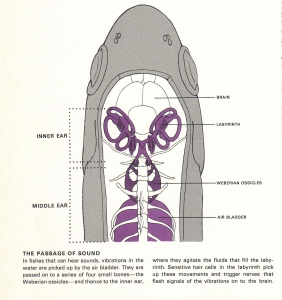How Fish Hear
Not all fish have the same morphology. Fish can have as many as 3 systems for hearing.
The lateral line is a line of nerves (neuromasts) that extend out of the side of the body of a fish. These nerves sense “particle motion” or the physical movement of the water.
The swim bladder is comparable to the diaphragm inside the ears of terrestrial animals. It helps mediate buoyancy and also to absorb pressure gradient energy and convert it to physical motion, which is transmitted by Webberian ossicles to the fish’s inner ear. These are like our own middle ear bones, the “hammer,” “anvil,” and “stirrup.”
Since fish can move in 3 dimensions (X,Y,and Z axis) their semi-circular canals are more complex than terrestrial mammal’s to help them orient.
Hearing systems are evolved based on a fish’s environment and survival needs. There is no lack of noise in the ocean. We want to make sure our noise doesn’t compromise the hearing habitats of these animals.

Fish can have as many as 3 systems for hearing.
Since fish can move in 3 dimensions (X,Y,and Z axis) their semi-circular canals are more complex than terrestrial mammal’s to help them orient.
Swim bladder
Cilia
neuromasts
particle motion
pressure gradient
Webberian ossicles
Otolith
Accelerometer
Sensory epithelia
Semi-circular canals
Halibut
Flounder


